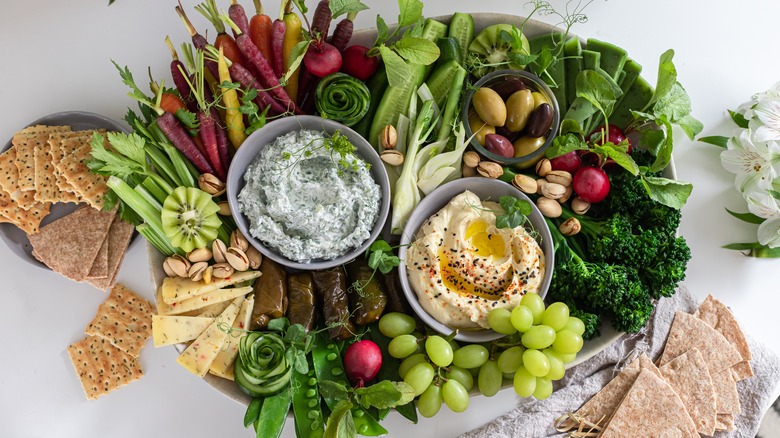Top Tips For Plating Up A Beautiful Veggie Platter
Whether arranged for a party buffet or a roundtable centerpiece at an office meeting, vegetable platters are a smorgasbord of bite-sized, nutrient-dense provisions perfect for feeding groups of people. Although veggie platters are often sold at supermarkets, making your own gives you more agency over the selection of produce and, of course, the aesthetic of the spread. But how exactly can you assemble a certifiably beautiful veggie platter? Daily Meal spoke with Chef Priyanka Naik, award-winning vegan chef, restaurateur, Food Network champion, and acclaimed writer and author of "The Modern Tiffin," for some exclusive tips on plating a visually striking vegetable platter.
First things first: The freshness of your vegetables is essential. Avoid making the common mistakes shoppers make when buying produce by selecting perfectly ripe, vividly-colored veggies free from mushy, soft spots and mold. Naik suggests not dicing vegetables with high water content before assembling the platter, proposing that home chefs avoid cutting "juicy veggies — like tomato, cucumbers — ahead of time, as they will become soggy."
Although salt is a great flavor enhancer, it also removes moisture from produce. When assembling a vegetable platter, Naik instructs us "not to salt any of the veggies until right before serving" to ensure they're plump and succulent. If your gathering is outdoors, serve the platter just before your guests arrive, and consider covering it with a glass top to give it an elegant shield from pests.
When making a veggie platter, become the artist
While preparation is key to maintaining the integrity of the individual vegetables, minding the color scheme and structure of your platter is what solidifies it as an edible art piece. Don't worry: This is the fun part. So tap into your highest creative self, and don't be afraid to think outside the box.
To give your veggie platter a garden-esque bouquet-style touch, Chef Priyanka Naik says, "Placing some leafy greens like various lettuce leaves, beet greens, and carrot tops at the bottom of the platter will help make the platter look full and lush." Although spinach and arugula are delicious, they're also small, so make sure to use large-leaf greens substantial enough to bolster the produce on the platter.
From sunshine-tinted carrots to lipstick-red tomatoes and grass-green broccoli, veggies are colorful enough to give a produce platter an eye-catching appeal. However, a thoughtful arrangement of those colors can make or break its visual appeal. Naik says, "Plating your vegetables to form an 'ombre' color gradient is not only beautiful, but it helps guests easily identify what each vegetable is." The platter color matters, too: Opt for muted, solid shades to let the veggie colors stand out.
Once your platter is finalized, Naik tells us to "garnish your dips with edible flowers and herbs to help elevate!" So, next time you need a stunning veggie platter for a meeting, party, or a weekday pick-me-up, keep Naik's expert advice in mind.

